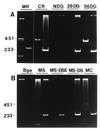Continuous in vitro propagation and differentiation of cultures of the intramolluscan stages of the human parasite Schistosoma mansoni
- PMID: 10220402
- PMCID: PMC21800
- DOI: 10.1073/pnas.96.9.4965
Continuous in vitro propagation and differentiation of cultures of the intramolluscan stages of the human parasite Schistosoma mansoni
Abstract
The metazoan parasitic blood flukes, Schistosoma spp., infect over 200 million people worldwide and cause extensive human morbidity and mortality. Research strategies for development of anti-schistosomal agents are impeded by the organism's complex molluscan-mammalian life cycle, which limits experimental approaches and availability of material. We derived long-term continuously proliferative cultures of Schistosoma mansoni sporocysts capable of generating cercariae in vitro. Cultured organisms retained the ability to parasitize the host, and they exhibited developmental regulation of candidate stage-specific genes in the host-free culture system. Evidence for expression of a reverse transcriptase also was found in the cultured organisms, pointing to this activity as a possible mechanistic contributor to the dynamic relationship between the parasite and its hosts. Continuous in vitro propagation of the asexual sporocyst stage allows isolation of clonally derived parasite populations and provides a means to study schistosomal molecular genetics, metabolism, and evasion of host defenses.
Figures



References
-
- Berquist N W, Colley D G. Parasitol Today. 1998;14:99–104. - PubMed
-
- Doenhoff M J. Parasitol Today. 1998;14:105–109. - PubMed
-
- Yoshino T P, Laursen J., Jr Parasitology. 1995;81:714–722. - PubMed
-
- Coustau C, Ataev G, Jourdane T, Yoshino T P. Exp Parasitol. 1997;87:77–87. - PubMed
-
- Hansen E L. In: Invertebrate Tissue Culture. Maramorosch K, editor. New York: Academic; 1976. pp. 75–99.
Publication types
MeSH terms
Substances
Grants and funding
LinkOut - more resources
Full Text Sources
Miscellaneous

